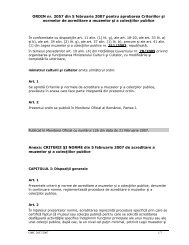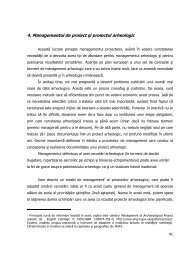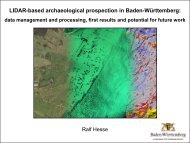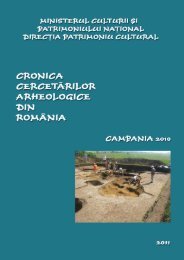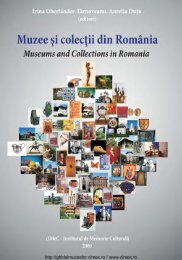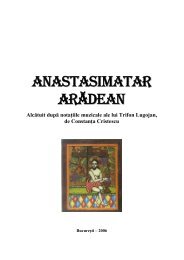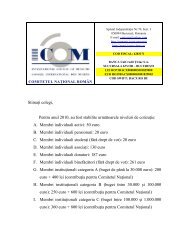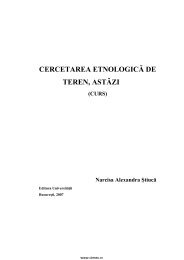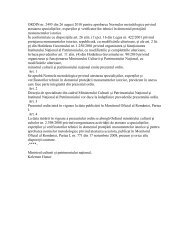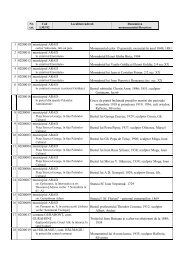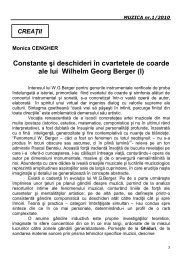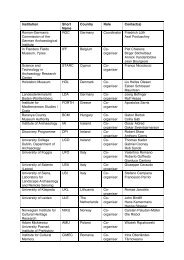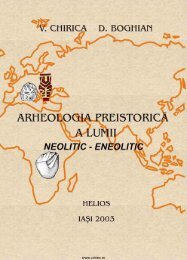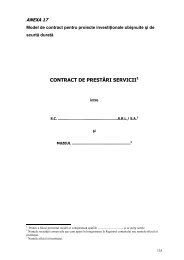pdf (15 MB) - cIMeC
pdf (15 MB) - cIMeC
pdf (15 MB) - cIMeC
You also want an ePaper? Increase the reach of your titles
YUMPU automatically turns print PDFs into web optimized ePapers that Google loves.
Cronica cercetărilor arheologice din România – campania 2006<br />
level appeared continued for another 2 m with a compact small<br />
stone platform, same as in S1 (and S37). Under the large<br />
stone level, several construction elements started to appear.<br />
S3 was very much affected by the root system. Under the<br />
topsoil, there is a level with several random large stone,<br />
continued downward by a sterile yellow sandy clay 50 cm thick<br />
layer. In the western half of S3 the yellow clay level has been<br />
removed to expose a charcoal rich burnt clay level, rich in<br />
ceramic fragments.<br />
The second area of interest was the situated at the eastern<br />
extremity of the upper plateau, occupied by the structures of<br />
the second tower (T2). The object of the excavation here was<br />
to establish the structure of the tower and the associated<br />
structural elements, identified by N. Lupu without offering more<br />
information. Eight trenches were identified in the field from<br />
previous excavations: 4, 13, 14, <strong>15</strong>, 28, 29 (mentioned by N.<br />
Lupu) and two more that were not labelled. Three new<br />
trenches have been explored. The object of the first trench was<br />
the cleaning of N. Lupu’s trench 28 in order to establish a<br />
continuous N-S profile through the interior of the tower, from<br />
the edge of the “intermediate terrace” to the edge of the cliff<br />
towards Tilişca village. S4 North and S4 South were intended<br />
to expose the ruins of the western wall of the tower and its<br />
exterior bedrock landscape. The pillage trench used by the<br />
local inhabitants to extract the large carved limestone blocks<br />
has been identified. This explains the disappearance of the<br />
wall, including the stone filler (emplecton). The excavation has<br />
exposed outside a thick burnt layer (over 30 cm), with several<br />
burnt beams and planks, covered by a thick level of brick<br />
fragments, followed by the topsoil. S28 exposed three carved<br />
limestone blocks from the northern exterior wall and part of the<br />
emplecton. Outside the wall, on the N side, a 2 m wide<br />
platform was exposed, made from carved bedrock (ca. 1 m)<br />
continued by a broken stone structure, in “opus incertus” (ca. 1<br />
m). This platform marks the eastern extremity of the upper<br />
fortifications. Preliminary observations seem to indicate that<br />
the “intermediate terrace” is modern and the result of the<br />
construction of a cart road around the steep hill made of the<br />
tower remains, therefore it is not part of the fortification itself.<br />
Inside the tower, the remains of the compacted clay floor were<br />
found, used for levelling the carved bedrock. The floor was<br />
covered by a charcoal layer 3 - 10 cm thick. The modern path<br />
is cutting through the middle of the tower and thus destroyed<br />
much of the stratigraphy of the interior of the structure.<br />
194. Topalu, com. Topalu, jud. Constanţa<br />
Punct: Stânca Topalu-Cekirgea, cariera Margela<br />
Cod sit: 63054.02<br />
Autorizaţia de evaluare de teren nr. 10/2006<br />
Colectiv: Cătălin Dobrinescu (MINAC), Ioan C. Opriş<br />
(FIB), studenţi UO Constanţa.<br />
În perioada <strong>15</strong>-31 iulie 2006 s-au desfăşurat săpături<br />
arheologice în punctul Stânca Topalu (com. Topalu, jud.<br />
Constanţa), iniţiate în campania 2006 în scopul evaluării de<br />
teren, prin practicarea unei secţiuni de mici dimensiuni în<br />
cetatea antică – S I (8 x 2 m). Micul sondaj stratigrafic în<br />
fortificaţia romano-bizantină de la Stânca Topalu a fost realizat<br />
după ce, în campaniile anterioare, fuseseră recoltate<br />
382<br />
fragmente ceramice romano-bizantine şi hallstattiene<br />
(Babadag II) de sub malurile botului de deal, pentru realizarea<br />
repertoriului de aşezări din landul Capidavei.<br />
Cercetările de teren (periegheză) din anii trecuţi în teritoriul<br />
Capidavei ne-au îndreptat atenţia şi asupra acestui important<br />
punct arheologic. Scopul principal al săpăturii din acest an a<br />
fost realizarea unui sondaj stratigrafic, respectiv verificarea<br />
succesiunii straturilor romane şi hallstattiene. În cercetarea<br />
noastră am utilizat şi informaţia lăsată de Pamfil Polonic<br />
despre starea fortificaţiei la începutul sec. XX – perioadă în<br />
care aceasta a fost afectată de exploatarea pietrei în carieră<br />
(cariera Margela), cam în aceeaşi vreme şi de către acelaşi<br />
antreprenor (ing. Cantacuzino din Brăila) cu exploatarea<br />
similară de la Capidava 1 .<br />
Timpul scurt şi număr redus de lucrători afectaţi acestei<br />
operaţiuni au determinat doar realizarea un mic sondaj de 2 x<br />
8 m, orientat N-S pe latura mică, în apropierea malului erodat.<br />
Suprafaţa rămasă din această fortificaţie este astăzi de aprox.<br />
6-7000 m 2 , latura de V şi de N fiind distruse de vechea carieră.<br />
Adâncimea la care a ajuns săpătura din 2006 este de -1,10<br />
m, situaţia stratigrafică surprinsă fiind următoarea:<br />
- vegetal (U.S. 1000): 0 -0,40 m, sol de culoare brună,<br />
cenuşoasă, străpuns de gropi de crotovine, cu pietre şi<br />
fragmente mici de ţiglă.<br />
- abandon (U.S. 1001): -0,40 -0,90 m, nivel de abandon,<br />
cenuşos ca textură şi culoare, ce conţine pietre şi ţigle,<br />
fragmente ceramice romano-bizantine (castroane şi amfore,<br />
sec. V-VI p.Chr.) şi intrusive (slave ).<br />
- distrugere (U.S. 1002): sol brun-roşcat, cu arsură de la lemn,<br />
aspect fărâmicios datorat arderii, chirpici ars, fragmente<br />
ceramice din a doua jumătate a sec. VI p.Chr. (), pietre şi<br />
oase de animale; reprezintă ultimul nivel de locuire al<br />
fortificaţiei romano-bizantine.<br />
Ultimelor unităţi stratigrafice le corespunde două ziduri ale<br />
unor locuinţe () din piatră legate cu pământ. Materialul<br />
arheologic recoltat din U.S. 1002 constă din vase de bucătărie<br />
sparte in situ, fragmente de amfore, fusaiole, oase de animale,<br />
o monedă bronz 2 acoperite de ţiglele şi pietrele construcţiei<br />
menţionate. Până acum, potrivit datelor numismatice<br />
cunoscute, cele mai târzii monede cunoscute de la Topalu<br />
datau din epoca lui Honorius 3 , iar moneda descoperită în 2006<br />
putea circula şi mai târziu, în sec. al VI-lea. În actualul stadiu al<br />
cercetărilor este imposibil să avansăm o limită finală clară a<br />
funcţionării fortificaţiei de la Topalu. Din analiza materialului<br />
ceramic recoltat până acum (veselă de masă microasiatică şi<br />
amfora „în formă de morcov” 4 ) se poate stabili că aceasta<br />
funcţiona în prima jumătate a sec. V p.Chr. Apoi, se remarcă şi<br />
materialul ceramic de factură „barbară”, constituit din oaleborcan<br />
lucrate cu mâna şi decorate cu alveole pe toată<br />
lungimea buzei, care seamănă cu materialul descoperit la<br />
Capidava în Corpul de Gardă 5 , ultimul datat în sec. VI p.Chr.<br />
Materialul arheologic rezultat se află actualmente la<br />
Laboratorul de restaurare-conservare a M.I.N.A.C., iar<br />
prelucrarea sa, funcţie de cele trei unităţi stratigrafice cărora le<br />
aparţine, va permite, pentru început, datarea momentului de<br />
final al fortificaţiei şi poate cauzele părăsirii acesteia.<br />
Ca o concluzie a sondajului arheologic de evaluare de<br />
teren din 2006, se impune epuizarea acestuia în 2007 şi, mai<br />
departe, deschiderea unei săpături arheologice sistematice<br />
pentru viitoarele campanii, în scopul obţinerii unor noi date<br />
asupra sistemului defensiv (în condiţiile în care o mare parte<br />
din fortificaţie a fost deja afectată de cariera de piatră), cât şi




